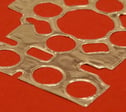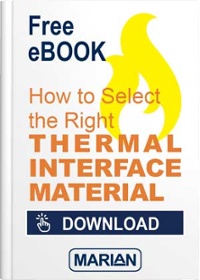
Thermal Interface Materials
In the next post in our hot summer blog series, we are writing about Heat Spreaders. Heat spreaders are thermal management solutions to be used in tight spaces where a traditional heat sink would not work. Applications range from smartphones to industrial and automotive applications. Heat spreaders utilize x-y thermal conductivity to move heat within a small space to a larger surface area, dissipating the heat in order to cool the device. They are made of thin copper and aluminum sheets with a conductive pressure sensitive adhesive laminated to one side. Their thin and flexible characteristics allow for 100% contact even on non-flat surfaces, optimizing thermal performance.
 Graphite
Graphite
In addition to copper and aluminum, graphite materials are superior in terms of heat spreading capabilities. They can spread heat up to 4x of copper and 7x of aluminum, making them ideal for high heat, demanding applications. Graphite is also very lightweight, 30% lighter than Aluminum and 80% lighter than copper. Marian has the highly technical capabilities to die-cut graphite into customer heat spreaders.
Because of their thin profiles (0.013 – 0.25mm) heat spreaders can be added to existing designs when a current solution is not meeting performance requirements. Another benefit of these materials is that they can be converted into custom complex designs and wound onto a roll. They can be peeled off of a liner and easily applied, reused, and replaced when necessary.
Material Suppliers
Common material suppliers for heat spreading materials include Polymer Science, 3M, Neograf, and Parker Chomerics. Marian maintains close relationships with all of these top material suppliers.
For a sample, quote, or a prototype of your custom heat spreader component, contact a Marian Engineer.


